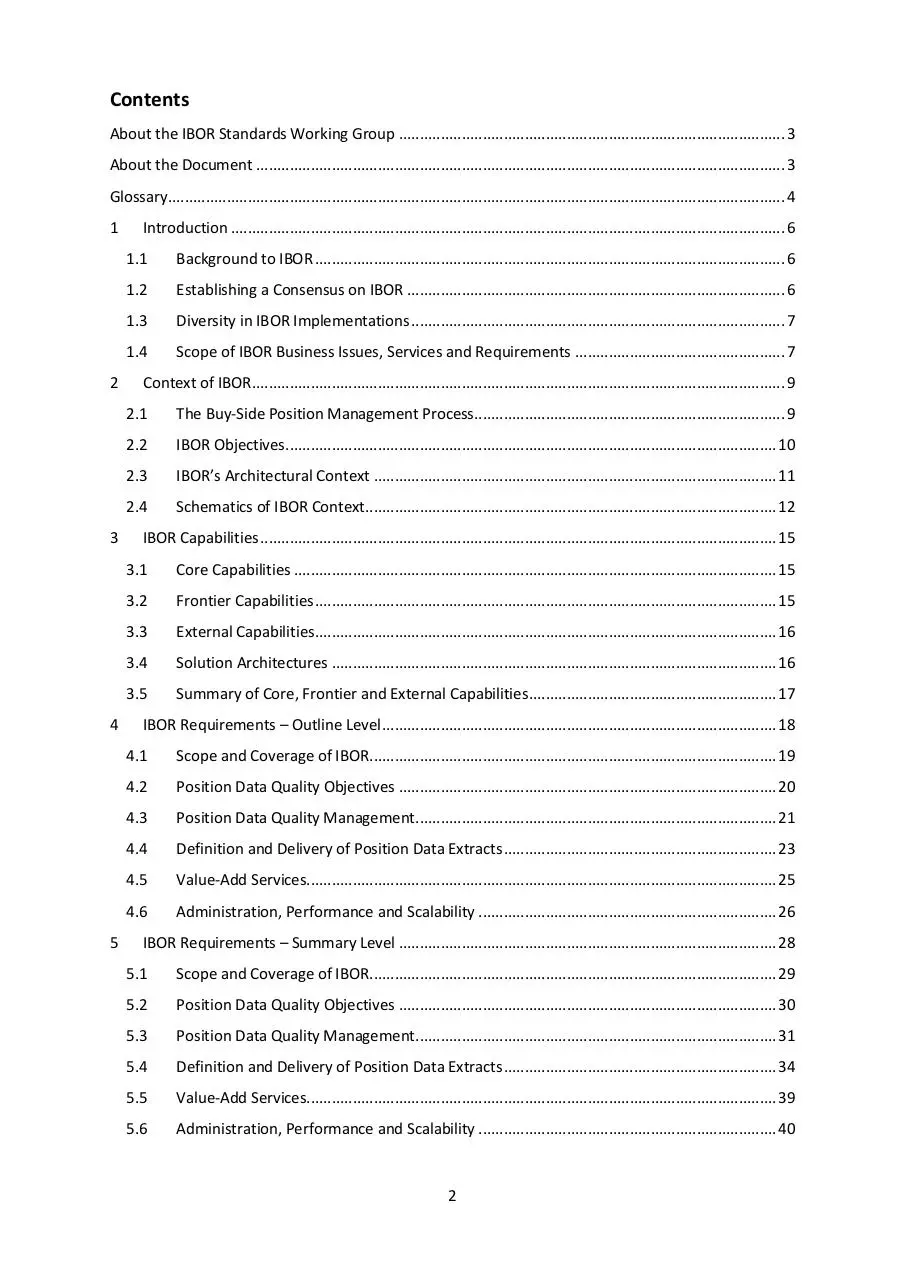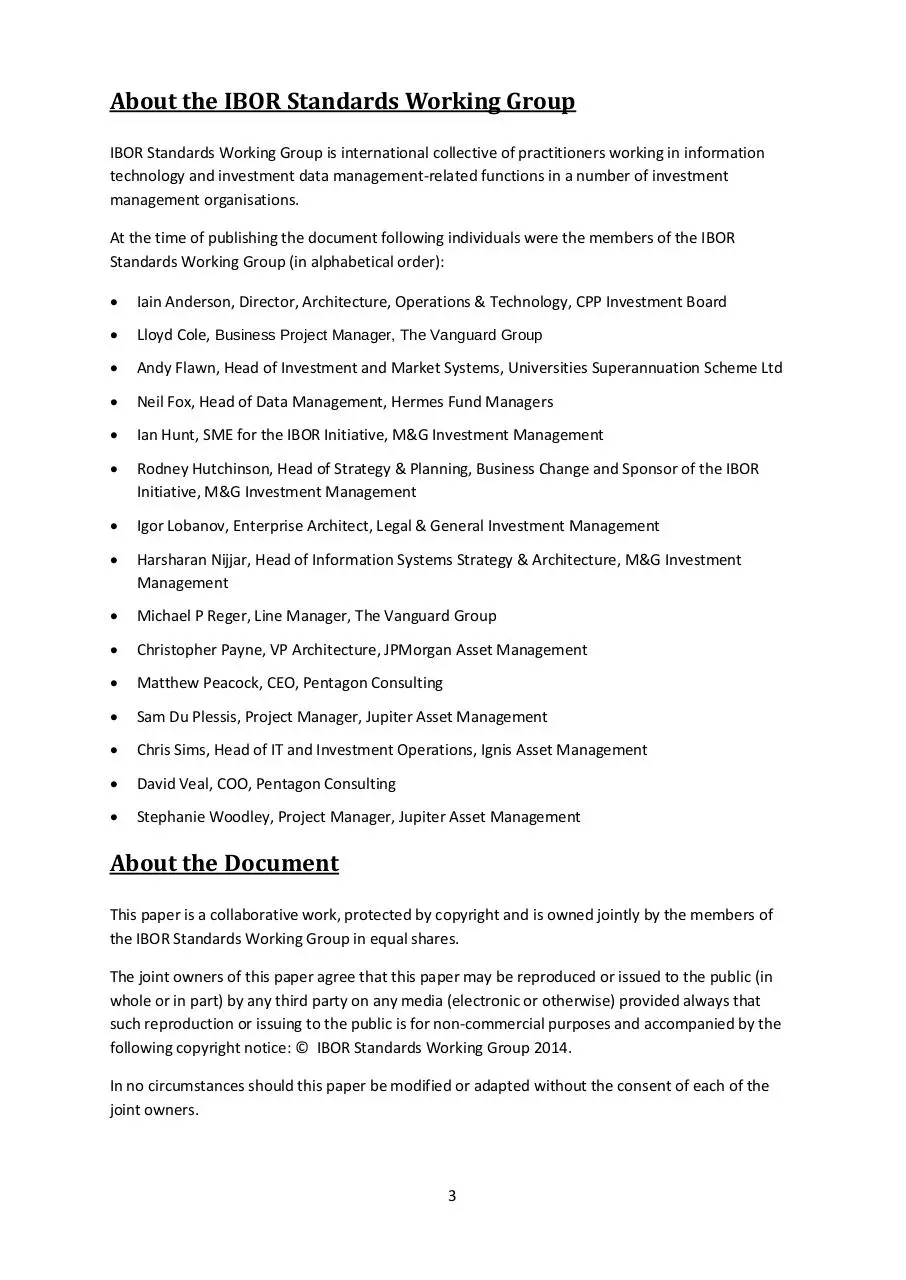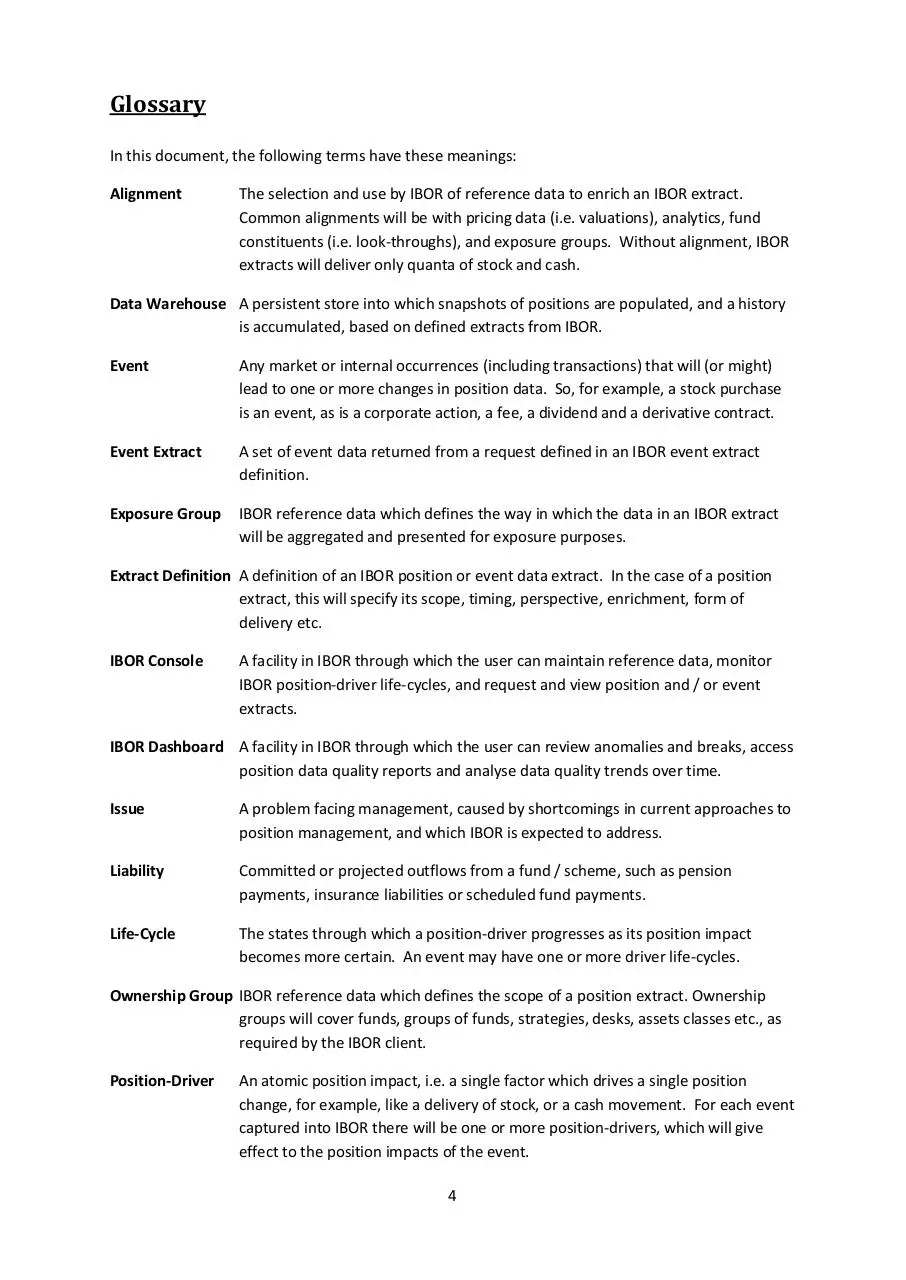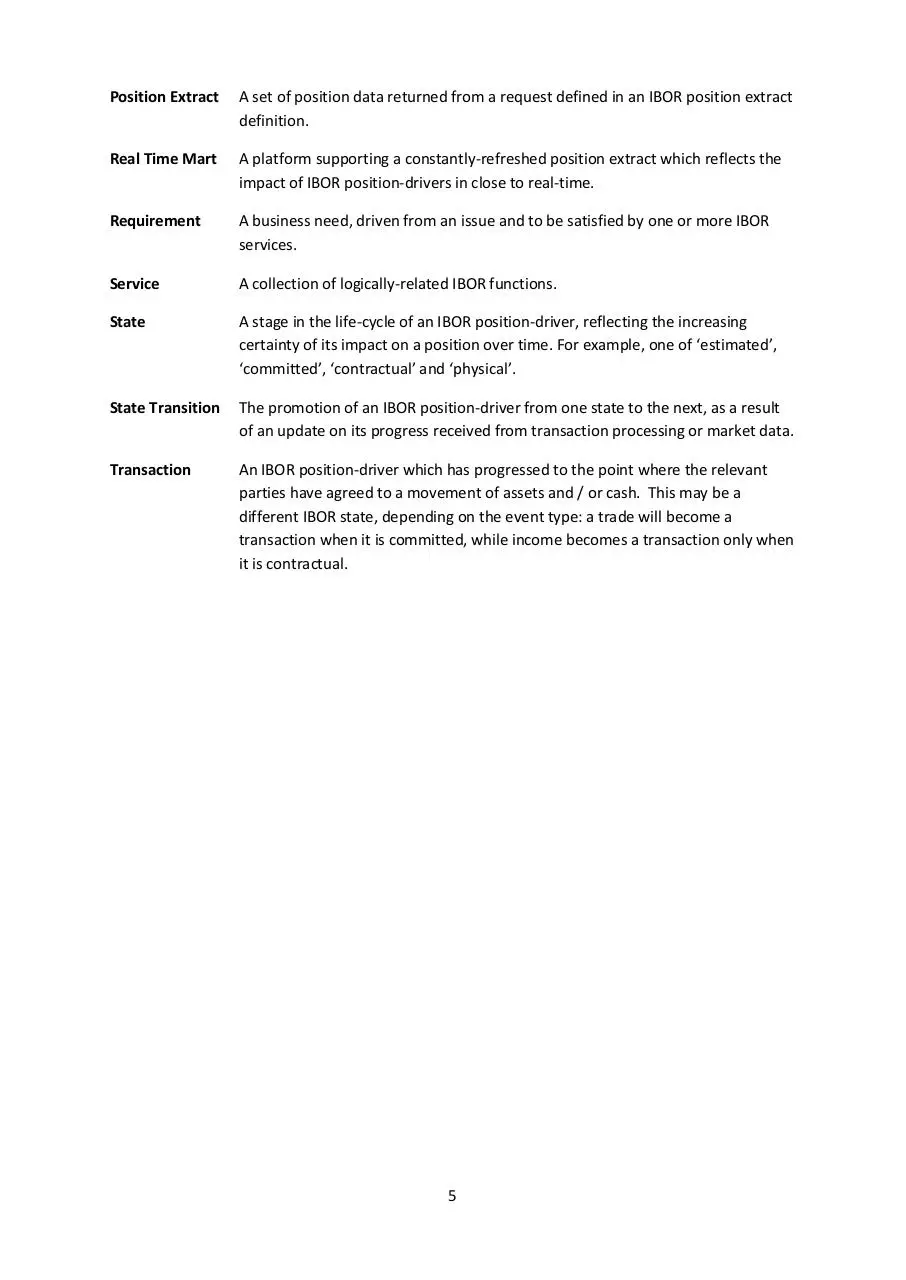IBOR Standards WPG IBOR Requirements Definition May 2014 (PDF)
File information
Title: IBOR Requirements Summary
Author: IBOR Standards Working Group
This PDF 1.6 document has been generated by Microsoft® Word 2010, and has been sent on pdf-archive.com on 23/05/2014 at 11:15, from IP address 86.141.x.x.
The current document download page has been viewed 4469 times.
File size: 1.15 MB (41 pages).
Privacy: public file





File preview
IBOR Standards Working Group
IBOR Requirements Definition
9th May 2014
Status of the paper:
This paper has been submitted to the IMA by the IBOR Standards
Working Group. The IMA is circulating it to members for consultation
and will consider endorsing it post-consultation, provided the feedback
from members does not indicate any substantive opposition.
1
Contents
About the IBOR Standards Working Group ............................................................................................ 3
About the Document .............................................................................................................................. 3
Glossary ................................................................................................................................................... 4
1
2
3
4
5
Introduction .................................................................................................................................... 6
1.1
Background to IBOR ................................................................................................................ 6
1.2
Establishing a Consensus on IBOR .......................................................................................... 6
1.3
Diversity in IBOR Implementations ......................................................................................... 7
1.4
Scope of IBOR Business Issues, Services and Requirements .................................................. 7
Context of IBOR ............................................................................................................................... 9
2.1
The Buy-Side Position Management Process.......................................................................... 9
2.2
IBOR Objectives..................................................................................................................... 10
2.3
IBOR’s Architectural Context ................................................................................................ 11
2.4
Schematics of IBOR Context.................................................................................................. 12
IBOR Capabilities ........................................................................................................................... 15
3.1
Core Capabilities ................................................................................................................... 15
3.2
Frontier Capabilities .............................................................................................................. 15
3.3
External Capabilities.............................................................................................................. 16
3.4
Solution Architectures .......................................................................................................... 16
3.5
Summary of Core, Frontier and External Capabilities ........................................................... 17
IBOR Requirements – Outline Level .............................................................................................. 18
4.1
Scope and Coverage of IBOR................................................................................................. 19
4.2
Position Data Quality Objectives .......................................................................................... 20
4.3
Position Data Quality Management ...................................................................................... 21
4.4
Definition and Delivery of Position Data Extracts ................................................................. 23
4.5
Value-Add Services................................................................................................................ 25
4.6
Administration, Performance and Scalability ....................................................................... 26
IBOR Requirements – Summary Level .......................................................................................... 28
5.1
Scope and Coverage of IBOR................................................................................................. 29
5.2
Position Data Quality Objectives .......................................................................................... 30
5.3
Position Data Quality Management ...................................................................................... 31
5.4
Definition and Delivery of Position Data Extracts ................................................................. 34
5.5
Value-Add Services................................................................................................................ 39
5.6
Administration, Performance and Scalability ....................................................................... 40
2
About the IBOR Standards Working Group
IBOR Standards Working Group is international collective of practitioners working in information
technology and investment data management-related functions in a number of investment
management organisations.
At the time of publishing the document following individuals were the members of the IBOR
Standards Working Group (in alphabetical order):
Iain Anderson, Director, Architecture, Operations & Technology, CPP Investment Board
Lloyd Cole, Business Project Manager, The Vanguard Group
Andy Flawn, Head of Investment and Market Systems, Universities Superannuation Scheme Ltd
Neil Fox, Head of Data Management, Hermes Fund Managers
Ian Hunt, SME for the IBOR Initiative, M&G Investment Management
Rodney Hutchinson, Head of Strategy & Planning, Business Change and Sponsor of the IBOR
Initiative, M&G Investment Management
Igor Lobanov, Enterprise Architect, Legal & General Investment Management
Harsharan Nijjar, Head of Information Systems Strategy & Architecture, M&G Investment
Management
Michael P Reger, Line Manager, The Vanguard Group
Christopher Payne, VP Architecture, JPMorgan Asset Management
Matthew Peacock, CEO, Pentagon Consulting
Sam Du Plessis, Project Manager, Jupiter Asset Management
Chris Sims, Head of IT and Investment Operations, Ignis Asset Management
David Veal, COO, Pentagon Consulting
Stephanie Woodley, Project Manager, Jupiter Asset Management
About the Document
This paper is a collaborative work, protected by copyright and is owned jointly by the members of
the IBOR Standards Working Group in equal shares.
The joint owners of this paper agree that this paper may be reproduced or issued to the public (in
whole or in part) by any third party on any media (electronic or otherwise) provided always that
such reproduction or issuing to the public is for non-commercial purposes and accompanied by the
following copyright notice: © IBOR Standards Working Group 2014.
In no circumstances should this paper be modified or adapted without the consent of each of the
joint owners.
3
Glossary
In this document, the following terms have these meanings:
Alignment
The selection and use by IBOR of reference data to enrich an IBOR extract.
Common alignments will be with pricing data (i.e. valuations), analytics, fund
constituents (i.e. look-throughs), and exposure groups. Without alignment, IBOR
extracts will deliver only quanta of stock and cash.
Data Warehouse A persistent store into which snapshots of positions are populated, and a history
is accumulated, based on defined extracts from IBOR.
Event
Any market or internal occurrences (including transactions) that will (or might)
lead to one or more changes in position data. So, for example, a stock purchase
is an event, as is a corporate action, a fee, a dividend and a derivative contract.
Event Extract
A set of event data returned from a request defined in an IBOR event extract
definition.
Exposure Group
IBOR reference data which defines the way in which the data in an IBOR extract
will be aggregated and presented for exposure purposes.
Extract Definition A definition of an IBOR position or event data extract. In the case of a position
extract, this will specify its scope, timing, perspective, enrichment, form of
delivery etc.
IBOR Console
A facility in IBOR through which the user can maintain reference data, monitor
IBOR position-driver life-cycles, and request and view position and / or event
extracts.
IBOR Dashboard A facility in IBOR through which the user can review anomalies and breaks, access
position data quality reports and analyse data quality trends over time.
Issue
A problem facing management, caused by shortcomings in current approaches to
position management, and which IBOR is expected to address.
Liability
Committed or projected outflows from a fund / scheme, such as pension
payments, insurance liabilities or scheduled fund payments.
Life-Cycle
The states through which a position-driver progresses as its position impact
becomes more certain. An event may have one or more driver life-cycles.
Ownership Group IBOR reference data which defines the scope of a position extract. Ownership
groups will cover funds, groups of funds, strategies, desks, assets classes etc., as
required by the IBOR client.
Position-Driver
An atomic position impact, i.e. a single factor which drives a single position
change, for example, like a delivery of stock, or a cash movement. For each event
captured into IBOR there will be one or more position-drivers, which will give
effect to the position impacts of the event.
4
Position Extract
A set of position data returned from a request defined in an IBOR position extract
definition.
Real Time Mart
A platform supporting a constantly-refreshed position extract which reflects the
impact of IBOR position-drivers in close to real-time.
Requirement
A business need, driven from an issue and to be satisfied by one or more IBOR
services.
Service
A collection of logically-related IBOR functions.
State
A stage in the life-cycle of an IBOR position-driver, reflecting the increasing
certainty of its impact on a position over time. For example, one of ‘estimated’,
‘committed’, ‘contractual’ and ‘physical’.
State Transition
The promotion of an IBOR position-driver from one state to the next, as a result
of an update on its progress received from transaction processing or market data.
Transaction
An IBOR position-driver which has progressed to the point where the relevant
parties have agreed to a movement of assets and / or cash. This may be a
different IBOR state, depending on the event type: a trade will become a
transaction when it is committed, while income becomes a transaction only when
it is contractual.
5
1 Introduction
1.1 Background to IBOR
Over the last 2 years there has been increasing project activity among asset managers to address
issues with position data: many firms now have initiatives planned or underway. This activity has
focused on the requirement for an Investment Book of Record (IBOR), to provide position data for
investment purposes, but also to ensure that consistency is maintained with position data for
trading, accounting, custody, performance and reporting.
IBOR has become a high profile topic across the buy-side. This document has been drafted for the
IBOR Standards Group, and is intended to provide a consensus definition of IBOR, to be published as
an initial standard. Its target readership includes:
Asset managers;
Asset owners;
Solution vendors / service providers;
Consultants / system integrators; and
Other standards bodies.
1.2 Establishing a Consensus on IBOR
Many industry solution vendors and service providers have become aware of IBOR’s high profile, and
there is now a diverse range of approaches and products which claim to deliver an IBOR. As a result,
there is confusion in the market, and definitions of IBOR have differed widely. There is a risk that
diverse and divergent products will be developed, without consideration to standards and interoperability. To address this, the IBOR Standards Group has been established, and aims to reach
consensus on:
1. The boundary around an IBOR;
2. The requirements and semantics of an IBOR; and
3. The inputs and outputs of an IBOR.
This document addresses the first two of these: a future paper from the Standards Group will
address the third.
Despite the range and diversity of potential IBOR users, the Standards Group believes that there is a
strong commonality in core position management functions, and in the business issues which IBOR
sets out to address. It would be highly supportive to the industry to have a well-understood,
consensus definition of IBOR, so that the expectations of managers, vendors and service providers
can be aligned. We aspire to a state similar to compliance technology, where solution providers
have developed genuinely comparable and competitive products.
6
1.3 Diversity in IBOR Implementations
All parties with an interest in IBOR are concerned to maintain a high level of quality in their position
data, and to implement active quality management in a position data context. All parties wish to see
complete and consistent position data, and to have confidence in its timeliness. However, the
Standards Group expects that each IBOR implementation will have differences which reflect the
business priorities and technology of the client. There are different classes of asset manager, asset
owner and scheme: each will experience the issues documented here to differing extents, and each
will focus on different subsets of the documented requirements.
Generally schemes and asset owners with multiple underlying asset managers are likely to focus on
the effective aggregation of positions sourced from their managers. They will want high quality
position data on a timely, but periodic basis, and may focus on a single cut per day, or per day per
time-zone. By contrast, asset managers with rapidly-traded funds, or with index funds with the need
for accurate intra-day cash, are more likely to demand real-time or near real-time positions.
Within each IBOR client, there will be a diversity of requirements for position views. The needs of
portfolio management, trading, post-trade / middle office, investment operations and accounting
are diverse, and each will require position data with a status and a timing which suits their varied
perspectives. Different users will have different appetites for uncertainty. It is a key challenge for
IBOR to deliver to this diverse requirement while maintaining strict consistency.
The Standards Group does not seek to define a single technical approach to the delivery of IBOR
services, and recognises that there will be diversity in the approaches and technologies deployed by
different vendors. Clients too will have diverse technical architectures and development strategies,
which will influence both their choice of solution and the services which they need the IBOR
application to deliver.
Certain technical approaches may be capable of delivering to a subset of the requirements, but
would fall short of a full solution. It is the responsibility of the client and the vendor in each context
to ensure that the proposed technical approach can satisfactorily deliver to the client’s specific
requirements.
1.4 Scope of IBOR Business Issues, Services and Requirements
The services set out in Section 3 describe the key functions of an IBOR platform, and are categorised
into ‘core’ and ‘frontier’ services. The core services reflect the functions which the IBOR Standards
Group expects any IBOR solution to offer. The frontier services may be delivered by the IBOR
platform if that platform is broadly defined, but in some contexts may be delivered through common
services within the client architecture, rather than from the IBOR product itself.
IBOR requirements are set out in outline in Section 4, together with the business issues which drive
those requirements. The requirements are articulated in more detail (but still at a summary level) in
Section 5. These describe generic industry needs for position data management. The requirements
follow the categorisation of services in Section 3 into ‘core’ and ‘frontier’.
The scope of positions envisaged for an IBOR implementation is comprehensive, and includes
physical stock, fixed income, derivative contracts, structures, property, deposits cash and foreign
7
exchange positions. We expect that individual implementations of IBOR will address subsets of asset
coverage, and that this will be dictated by the needs of individual managers.
IBOR’s focus is on position management, rather than transaction processing or accounting. While
the term ‘IBOR’ is now accepted in the industry as a label for initiatives of this kind, the industry
issues and requirements described in this document cover position views generally. They include:
Forecasts and estimated views;
Traded / committed views;
Contractual / accounting views;
Physical / custodial / settled views; and
Historical views.
IBOR’s focus is therefore not only on position records for investment decision purposes, although
the support of investment decision-making is a primary target.
8
2 Context of IBOR
2.1 The Buy-Side Position Management Process
While IBOR is a new component in most asset management architectures, its primary function is not
new. The central role of IBOR is to deliver position data to users and to consuming applications: all
managers have existing mechanisms in place to achieve this. IBOR’s role is to do an existing job
better, not to fulfil a completely new role.
In conventional buy-side architectures, front office systems are populated with position data on a
periodic (usually daily) basis. When the new position data is loaded, it overwrites the previous
version of the position data: the over-written data is acknowledged to be incomplete, and is rarely
used in any control or reconciliation process. This flush / refresh process is assumed as the position
management approach by most of the specialist software products in the front office space. It is
materially different only where the asset manager implements a common platform for front, middle
and back office support.
The range of events which drive position change is wide: events which may have an intra-day
impact, but are unlikely to be reflected in a conventional Order Management System include:
Collateral movements;
Injections / withdrawals;
Exercising of options;
Some corporate actions;
Third party hedging transactions;
Class action / litigation proceeds;
Underwriting commitments;
Etc.
The intra-day adjustment of positions to take account only of trades is therefore materially deficient.
The position construction and maintenance process has three key components:
An accounting end of day process;
A batch overnight process which adds in some position drivers missing from the accounting
view; and
An intra-day real-time process (usually driven from the Order Management System) which
adjusts the start of day positions with the impact of trades.
There is a clear limitation with each of these three steps:
The accounting end-of-day is an accruals view, and by definition only includes movements
which have been posted up to that point. It is therefore a single-status, retrospective view.
The overnight enrichment process is generally partial in its effect: it adds in known income and
corporate actions, but is unlikely to include other expected movements which may have a
material impact on positions.
The real-time intra-day updates managed by the OMS generally only take account of the impact
of orders and trades. Other drivers are ignored, with the assumption that they will be picked up
through a future flush / refresh of the start-of-day position data.
9
Download IBOR Standards WPG - IBOR Requirements Definition May 2014
IBOR Standards WPG - IBOR Requirements Definition May 2014.pdf (PDF, 1.15 MB)
Download PDF
Share this file on social networks
Link to this page
Permanent link
Use the permanent link to the download page to share your document on Facebook, Twitter, LinkedIn, or directly with a contact by e-Mail, Messenger, Whatsapp, Line..
Short link
Use the short link to share your document on Twitter or by text message (SMS)
HTML Code
Copy the following HTML code to share your document on a Website or Blog
QR Code to this page

This file has been shared publicly by a user of PDF Archive.
Document ID: 0000164720.